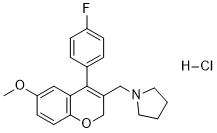AX-024 is a novel, potent and orally bioavailable inhibitor of the TCR-Nck interaction that selectively inhibits TCR-triggered T cell activation (IC50 1 nM). A wide range of autoimmune and inflammatory diseases caused by human T cells may be treated by blocking an immediate TCR signal.
Physicochemical Properties
| Molecular Formula | C21H23CLFNO2 |
| Molecular Weight | 375.864228487015 |
| Exact Mass | 375.14 |
| Elemental Analysis | C, 67.11; H, 6.17; Cl, 9.43; F, 5.05; N, 3.73; O, 8.51 |
| CAS # | 1704801-24-0 |
| Related CAS # | AX-024;1370544-73-2 |
| PubChem CID | 129909862 |
| Appearance | White to off-white solid powder |
| Hydrogen Bond Donor Count | 1 |
| Hydrogen Bond Acceptor Count | 4 |
| Rotatable Bond Count | 4 |
| Heavy Atom Count | 26 |
| Complexity | 480 |
| Defined Atom Stereocenter Count | 0 |
| InChi Key | DGBCIMPGYRVTPD-UHFFFAOYSA-N |
| InChi Code | InChI=1S/C21H22FNO2.ClH/c1-24-18-8-9-20-19(12-18)21(15-4-6-17(22)7-5-15)16(14-25-20)13-23-10-2-3-11-23;/h4-9,12H,2-3,10-11,13-14H2,1H3;1H |
| Chemical Name | 1-[[4-(4-fluorophenyl)-6-methoxy-2H-chromen-3-yl]methyl]pyrrolidine;hydrochloride |
| Synonyms | AX-024 hydrochloride; AX-024; AX 024; AX024 HCl |
| HS Tariff Code | 2934.99.9001 |
| Storage |
Powder-20°C 3 years 4°C 2 years In solvent -80°C 6 months -20°C 1 month Note: Please store this product in a sealed and protected environment, avoid exposure to moisture. |
| Shipping Condition | Room temperature (This product is stable at ambient temperature for a few days during ordinary shipping and time spent in Customs) |
Biological Activity
| Targets | IL-6; IL-10; IL-17A |
| ln Vitro | Compared to AX-000 hit, AX-024 hydrochloride has a potency that is >10,000-fold greater in terms of preventing TCR-triggered T cell proliferation. AX-024 hydrochloride has an inhibitory effect at a concentration of 1 pM or less, but its IC50 in this assay is 1 nM. At a concentration of 10 nM, AX-024 hydrochloride significantly outperforms AX-000 as an inhibitor of cytokine release by human peripheral blood mononuclear cells stimulated with anti-CD3 and significantly reduces the production of interleukin-6 (IL-6), tumor necrosis factor-α (TNFα), interferon-γ (IFN-γ), IL-10, and IL-17A. AX-024 hydrochloride strongly inhibits T cell proliferation in OT1Tg T cells that are WT for the PRS mutation in mice bearing wild-type (WT) CD8+ T cells at a concentration of 0.1 nM. In these cells, coimmunoprecipitation experiments demonstrate that Nck recruitment to the TCR is induced upon stimulation in the absence of drug but is inhibited in the presence of AX-024 hydrochloride in a dose-dependent manner at concentrations beginning at 1 nM[1]. |
| ln Vivo | In comparison to the vehicle group, the AX-024 hydrochloride-treated group has fewer scales and lessened skin thickening. Significantly lessening the thickness of both skin layers, AX-024 hydrochloride works best on the dermis, which resembles the skin of mice treated with a control cream devoid of imiquimod (IMQ). In both assays, AX-024 hydrochloride significantly reduces the quantity of inflammatory cells in the airways. In contrast to mice receiving the vehicle, which experience persistent ataxia and loss of the righting reflex, mice receiving AX-024 hydrochloride experience a rapid recovery from neurological impairment and weight loss, becoming symptom-free by day 30[1]. |
| Cell Assay | Cell Trace Violet is used to mark the spleen B cells from C57BL/6 mice. The cells are then incubated for 72 hours with either anti-IgM (10 mg/mL) or anti-CD40 (5 mg/mL), as well as IL-4 (5 ng/mL) or LPS (2.5 mg/mL), in the presence of various concentrations of AX-024 hydrochloride. According to the total number of cell divisions, proliferation is calculated[1]. |
| References |
[1]. First-in-class inhibitor of the T cell receptor for the treatment of autoimmune diseases. Sci Transl Med. 2016 Dec 21;8(370):370ra184. |
Solubility Data
| Solubility (In Vitro) |
DMSO: ~75 mg/mL (~199.5 mM) Water: ~4 mg/mL (~10.6 mM) Ethanol: ~18 mg/mL (~47.9 mM) |
| Solubility (In Vivo) |
Solubility in Formulation 1: ≥ 2.5 mg/mL (6.65 mM) (saturation unknown) in 10% DMSO + 40% PEG300 + 5% Tween80 + 45% Saline (add these co-solvents sequentially from left to right, and one by one), clear solution. For example, if 1 mL of working solution is to be prepared, you can add 100 μL of 25.0 mg/mL clear DMSO stock solution to 400 μL PEG300 and mix evenly; then add 50 μL Tween-80 to the above solution and mix evenly; then add 450 μL normal saline to adjust the volume to 1 mL. Preparation of saline: Dissolve 0.9 g of sodium chloride in 100 mL ddH₂ O to obtain a clear solution. Solubility in Formulation 2: ≥ 2.5 mg/mL (6.65 mM) (saturation unknown) in 10% DMSO + 90% (20% SBE-β-CD in Saline) (add these co-solvents sequentially from left to right, and one by one), clear solution. For example, if 1 mL of working solution is to be prepared, you can add 100 μL of 25.0 mg/mL clear DMSO stock solution to 900 μL of 20% SBE-β-CD physiological saline solution and mix evenly. Preparation of 20% SBE-β-CD in Saline (4°C,1 week): Dissolve 2 g SBE-β-CD in 10 mL saline to obtain a clear solution. Solubility in Formulation 3: ≥ 2.5 mg/mL (6.65 mM) (saturation unknown) in 10% DMSO + 90% Corn Oil (add these co-solvents sequentially from left to right, and one by one), clear solution. For example, if 1 mL of working solution is to be prepared, you can add 100 μL of 25.0 mg/mL clear DMSO stock solution to 900 μL of corn oil and mix evenly. (Please use freshly prepared in vivo formulations for optimal results.) |
| Preparing Stock Solutions | 1 mg | 5 mg | 10 mg | |
| 1 mM | 2.6606 mL | 13.3028 mL | 26.6057 mL | |
| 5 mM | 0.5321 mL | 2.6606 mL | 5.3211 mL | |
| 10 mM | 0.2661 mL | 1.3303 mL | 2.6606 mL |
